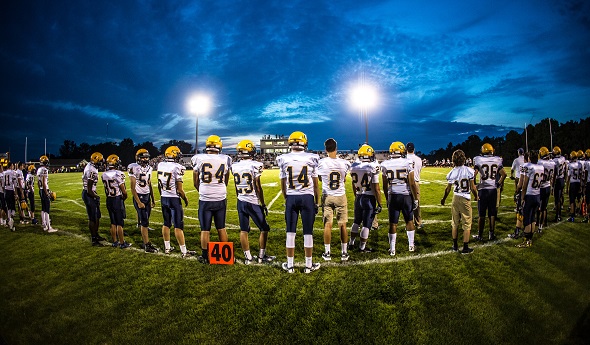
MHSAA Opposes Big Ten Friday Football
November 2, 2016
By Geoff Kimmerly
Second Half editor
The executive director of the Michigan High School Athletic Association said today that he is “disappointed and disheartened” by the Big Ten Conference announcement that it will play and televise football games on Friday nights beginning with the 2017 season.
Friday night football remains one of the strongest and longest-standing traditions in high school athletics, and the MHSAA has fought since the start of this century to keep Friday nights sacred against the overstepping of college football and the damage televised Big Ten games are now expected to cause to attendance and media coverage of the sport at the high school level.
MHSAA Executive Director John E. “Jack” Roberts was contacted by both Big Ten Conference commissioner Jim Delany and Michigan State University athletic director Mark Hollis before the decision was announced. Roberts said he is appreciative of Michigan State and University of Michigan’s low tolerance to be included in this venture – at most, both will host a Thursday or Friday night game during Labor Day weekend and play one Friday night away game during the remainder of a season – but remains frustrated that similar respect for high school football was not shown by the conference as a whole.
Michigan State has played Friday night games during Labor Day weekend the last six seasons, hosting five and playing at Western Michigan University in 2015. However, most Michigan high school games continue to be scheduled and played on the Thursday before Labor Day, relieving holiday travel conflicts in most communities. University of Michigan did play on the Thursday before Labor Day at University of Utah in 2015, but has not played on a Friday night of Labor Day weekend this decade. The Wolverines are one of five Big Ten schools without a Friday night game in 2017.
“We are saddened by this decision. We had hoped that the Big Ten Conference would stay above this. We think this cheapens the Big Ten brand,” Roberts said. “Fans won’t like this. Recruits won’t like this. And high school football coaches won’t like this.
“We are grateful that Michigan State University and the University of Michigan are trying to minimize the effects of this decision by the Big Ten. But overall, this is just the latest step by major college athletics in the pursuit of cash that is just crushing high school sports.”
The MHSAA has shown its opposition to the use of Friday nights for televised collegiate football games for more than 15 years, dating back to 2001 when the NCAA lifted its restrictions on Friday night telecasts, which at first led to the broadcasting of “mid-major conference” games on the same night traditionally reserved for high school athletes.
The MHSAA launched in 2001 its “Save Our Friday Nights” campaign to emphasize the role that Friday night high school athletic events play in communities and to rally MHSAA member schools to contact NCAA member school football coaches, athletic directors and conference commissioners to voice their concerns.
In addition to causing lower attendance at events going up against Big Ten football games, Roberts anticipates that Friday night college games also will leave high school football as a secondary priority in many media markets. More than 80 radio stations statewide cover high school games regularly, but many also carry Michigan State or University of Michigan football. High school football could lose significant time on local TV highlights shows and in print and online coverage as well, as resources are diverted to cover a college game – potentially quieting significantly the positive buzz that comes from the typical high school football Friday night.
“Everyone knows that football is struggling right now,” Roberts said. “It’s getting a lot of bad publicity. Participation is declining. And now this; there couldn’t be worse timing.”
PHOTO: Grand Ledge takes on Okemos under the Friday night lights this season. (Click to see more from HighSchoolSportsScene.com.)

Council Discusses Transfer, 5th-Quarter Rules in Charting Future Work During Fall Meeting
By
Geoff Kimmerly
MHSAA.com senior editor
December 18, 2025
The Representative Council of the Michigan High School Athletic Association considered several reports concerning ongoing business relevant to its member schools, discussed topics surrounding the MHSAA’s transfer and 5th-quarter rules, and conducted its annual elections among other activities during its Fall Meeting on Dec. 5 in East Lansing.
Generally, the Council takes only a few actions during its Fall Meeting, with topics often introduced for additional consideration and action during its meetings in March and May. The Council took only one action at this meeting, to approve its annual audit, but discussed several topics that will be delved into further throughout the remainder of this school year.
A significant portion of Council discussion regarded the MHSAA transfer and 5th-quarter allowance rules. The transfer conversation focused primarily on students who play as part of non-MHSAA sports organizations during their first year or years of high school but wish to then play at a member high school. The Council also received an update on the Transfer Tracker tool under development that will provide schools greater guidance on eligibility determinations by monitoring when students change schools after ninth grade.
The 5th-quarter conversation considered how allowances made in recent years in basketball, football, soccer, lacrosse, baseball and field hockey have aligned with the intent of that allowance – to help schools save subvarsity teams from elimination because of low participation by allowing athletes to play on varsity and subvarsity teams simultaneously over a set number of periods each week.
The Council received updates on this fall’s inaugural MHSAA Field Hockey Tournament and also on the first boys volleyball season to be played during Spring 2026. MHSAA staff also informed the Council on a baseball rule proposal that would require a double first base, recent viewership of NFHS Network broadcasts, and MHSAA Sports Medicine Advisory Committee discussions especially concerning the statewide shortage of athletic trainers in schools. Additional updates were provided on MHSAA athletic director Update meeting and in-service programs and other administrative topics.
The Fall Meeting also saw elections of Council officers for the upcoming year. Brighton athletic director John Thompson was reelected president after completing the previous president’s term this summer and fall. Calumet teacher and past athletic director Sean Jacques was reelected as Council vice president after completing Thompson’s term, and Vic Michaels, director of physical education and athletics for the Archdiocese of Detroit, was reelected as secretary-treasurer.
Additionally, Wyoming Godfrey-Lee Schools superintendent Arnetta Thompson and Freeland Middle School principal Jennifer Thunberg were appointed for second two-year terms on the Council.
The Representative Council is the legislative body of the MHSAA. All but five members are elected by member schools. Four members are appointed by the Council to facilitate representation of females and minorities, and the 19th position is occupied by the Superintendent of Public Instruction or designee.
The MHSAA is a private, not-for-profit corporation of voluntary membership by more than 1,500 public and private senior high schools and junior high/middle schools which exists to develop common rules for athletic eligibility and competition. No government funds or tax dollars support the MHSAA, which was the first such association nationally to not accept membership dues or tournament entry fees from schools. Member schools which enforce these rules are permitted to participate in MHSAA tournaments, which attract more than 1.4 million spectators each year.

